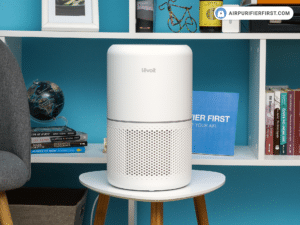Lately, I’ve tried the Shark HP102 air purifier, which stands as a direct competitor to the Levoit Core 300S. Why? Because they share similar construction, filtration technology, and some built-in features.
However, despite their almost identical sizes, the Levoit Core 300S covers rooms of up to 219 sq. ft., nearly double the coverage of the Shark HP102’s 124 sq. ft. Both use a three-stage filtration technology, including a pre-filter, a True HEPA filter, and an activated carbon filter.

Levoit’s filter lasts about 6-8 months, while the Shark’s is slightly more durable, lasting about 6-12 months. Yet, the replacement filter for the Shark is noticeably more expensive than the one for Levoit.
What I also like about both units are their air quality sensors, air quality indicators, and auto mode features. Additionally, the Levoit Core 300S has a smart app feature (VeSync app).
I performed thorough testing of these air purifiers, and you can find all the results in the table just below this paragraph. For a more comprehensive understanding of any specific test result, I recommend checking out individual reviews here on the Air Purifier First website. Trust me; it’s worth reading them!
Shark Vs Levoit Specifications
 |
 |
|
| Manufacturer | Shark | Levoit |
| Model | HP102 | Core 300S |
| Dimensions | 8.7 x 8.7 x 14.6 inches (22 x 22 x 37 cm) | 8.7 x 8.7 x 14.2 inches (22 x 22 x 36 cm) |
| Room Coverage | 124 sq. ft. (11.5 m²) | 219 sq. ft. (20 m²) |
| Performance Ratings | ||
| Filtration Technology | Pre-filter, Activated Carbon Filter, and True HEPA Filter | Pre-filter, True HEPA Filter, and Activated Carbon Filter |
| Filter Replacement Indicator | Yes | Yes |
| Filter Longevity | 6-12 months | 6-8 months |
| Power | 24W | 26W |
| Operating Costs Ratings | ||
| Working Modes | 4 – Speed 1, Speed 2, Speed 3, and Speed 4 | 5 – Sleep Mode, Speed 1, Speed 2, Speed 3, and Auto Mode |
| Air Quality Sensor | Yes | Yes |
| Air Quality Indicator | Yes | Yes |
| Auto Mode | Yes | Yes |
| Smart App | No | Yes |
| Voice Control | No | Yes |
| Noise Levels | 41.7 – 56.5 dBA | 41.4 – 65.2 dBA |
| Noise Ratings | ||
| Warranty | 2-year | 2-year |
| In-Depth Review | Shark HP102 | Levoit Core 300S |
| Price | Check Price on Amazon | Check Price on Amazon |
Which One Does It Better?
This was a turbulent battle. The Shark HP102 is a significantly better option for bedrooms or similar spaces due to its remarkably quiet motor. However, it comes with a steep price tag and performed slightly less impressively in performance tests when compared to the Core 300S.
Contrarily, the Levoit Core 300S not only outperforms its counterpart but also boasts plenty of advanced features. It can be connected to the amazing VeSync smart app and covers much larger rooms. All these are the reasons why I would always choose the Levoit Core 300S over the Shark HP102 air purifier.
I would go with the Shark only if I planned to use it in a bedroom.
If you have any questions about these two air purifiers, please leave a comment in the comment section below the article.
Leave a Reply